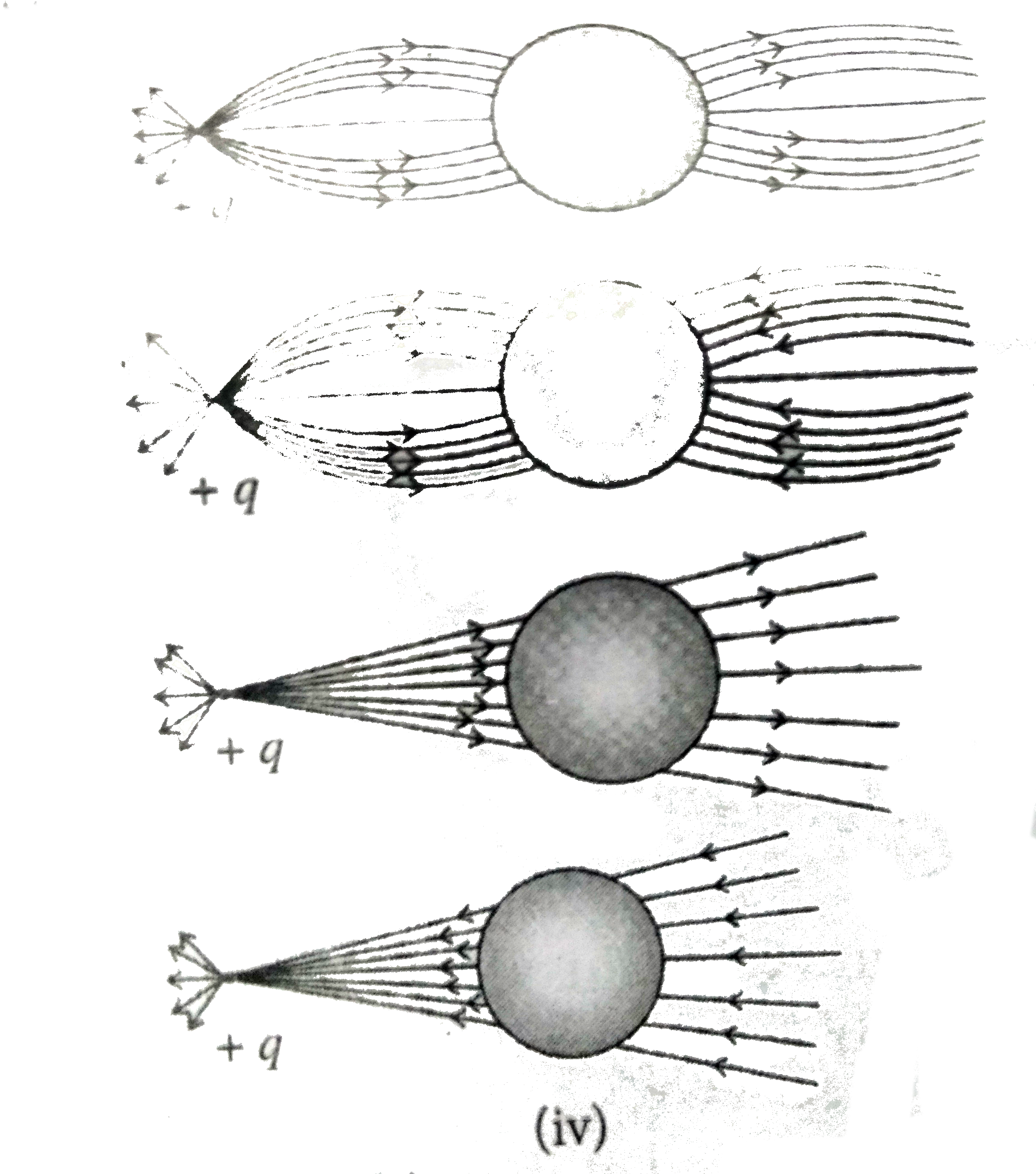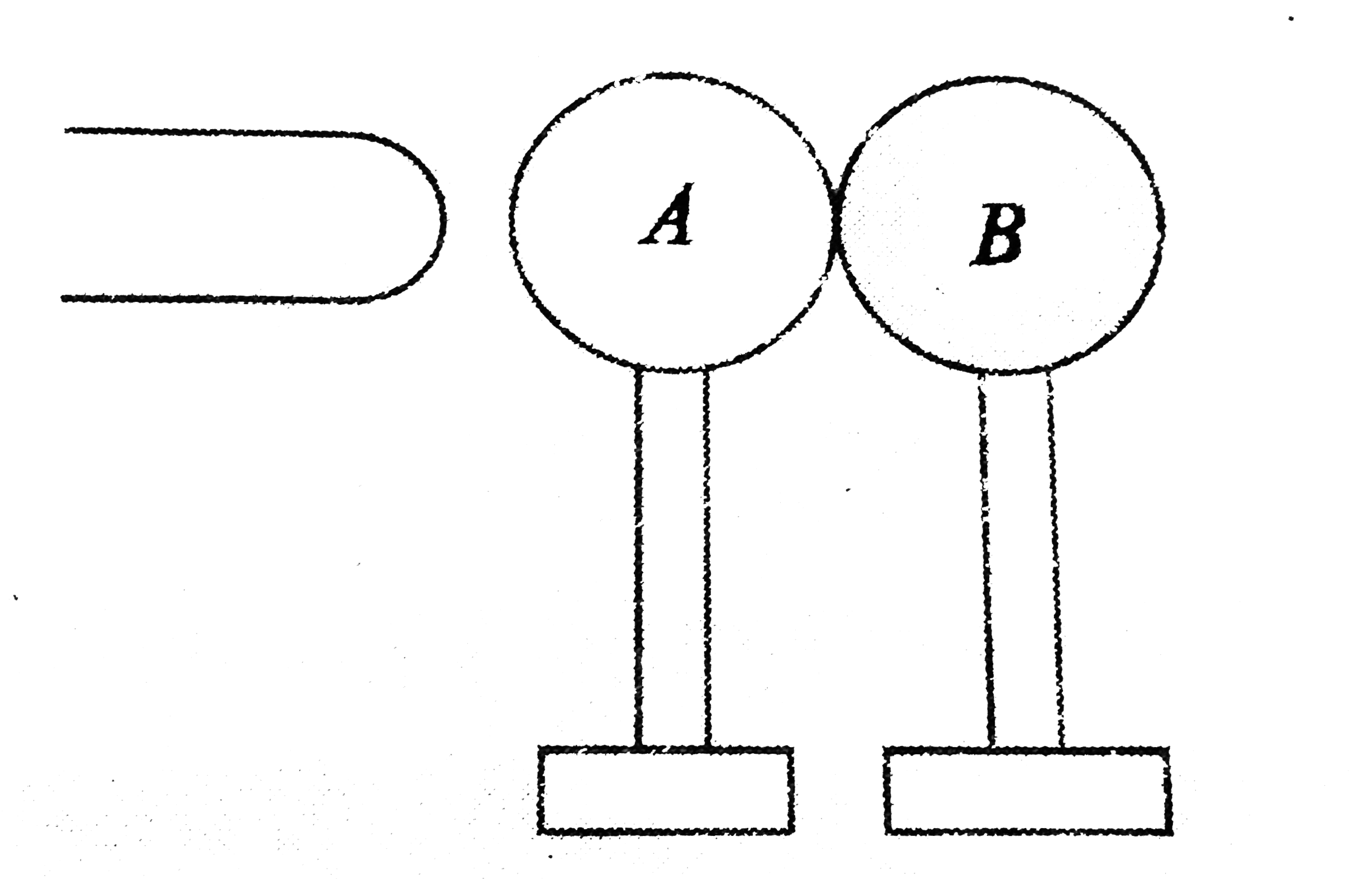A positively charged insulator is brought near(but does not touch) two metallic sphere that are in contact. The metallic spheres are then separated. The sphere which was initially farthest from the insulator will have:
no net charge
a negative charge
a positive charge
either a negative or a positive charge.
The correct Answer is:C
To solve the problem, we need to analyze the situation step-by-step:
Step 1: Understand the setup
We have two metallic spheres that are in contact with each other, and a positively charged insulator is brought near them. The key point is that the insulator does not touch the spheres.
Hint: Remember that metallic spheres can conduct electricity and can redistribute their charges when influenced by an external electric field.
Step 2: Induction Process
When the positively charged insulator is brought near the two metallic spheres, it creates an electric field that affects the charges in the spheres. The positive charge of the insulator will repel positive charges in the spheres and attract negative charges.
Hint: Think about how charges behave in the presence of an electric field. Positive charges are repelled, while negative charges are attracted.
Step 3: Charge Redistribution
Due to the influence of the positively charged insulator, the following happens:
- The sphere that is closer to the insulator will have negative charges induced on its surface (due to attraction of electrons from the metal).
- Consequently, the other sphere (which is farther from the insulator) will have a positive charge induced on its surface (due to the repulsion of positive charges).
Hint: Consider the principle of conservation of charge. The total charge in the system remains constant, but the distribution of charges can change.
Step 4: Separation of the Spheres
After the charges have redistributed, the spheres are then separated. The sphere that was initially farther away from the insulator will retain the positive charge that was induced on its surface.
Hint: Remember that once the spheres are separated, they retain the charges they had at the moment of separation.
Step 5: Conclusion
The sphere that was initially farthest from the positively charged insulator will have a positive charge after the separation.
Final Answer: The sphere which was initially farthest from the insulator will have a positive charge.
Summary of the Solution
1. A positively charged insulator is brought near two metallic spheres.
2. Induction occurs, causing charge redistribution.
3. The closer sphere acquires a negative charge, while the farther sphere acquires a positive charge.
4. Upon separation, the farther sphere retains its positive charge.
We have two metallic spheres that are in contact with each other, and a positively charged insulator is brought near them. The key point is that the insulator does not touch the spheres.
When the positively charged insulator is brought near the two metallic spheres, it creates an electric field that affects the charges in the spheres. The positive charge of the insulator will repel positive charges in the spheres and attract negative charges.
Due to the influence of the positively charged insulator, the following happens:
- The sphere that is closer to the insulator will have negative charges induced on its surface (due to attraction of electrons from the metal).
- Consequently, the other sphere (which is farther from the insulator) will have a positive charge induced on its surface (due to the repulsion of positive charges).
After the charges have redistributed, the spheres are then separated. The sphere that was initially farther away from the insulator will retain the positive charge that was induced on its surface.
The sphere that was initially farthest from the positively charged insulator will have a positive charge after the separation.
1. A positively charged insulator is brought near two metallic spheres.
2. Induction occurs, causing charge redistribution.
3. The closer sphere acquires a negative charge, while the farther sphere acquires a positive charge.
4. Upon separation, the farther sphere retains its positive charge.
Topper's Solved these Questions
- BOOK - CENGAGE PHYSICS ENGLISHCHAPTER - COULOMB LAW AND ELECTRIC FIELDEXERCISE - Multiple Correct Answers Type2videos
COULOMB LAW AND ELECTRIC FIELD
- BOOK - CENGAGE PHYSICS ENGLISHCHAPTER - COULOMB LAW AND ELECTRIC FIELDEXERCISE - Comprehension Type2videos
COULOMB LAW AND ELECTRIC FIELD
- BOOK - CENGAGE PHYSICS ENGLISHCHAPTER - COULOMB LAW AND ELECTRIC FIELDEXERCISE - Integer8videos
COULOMB LAW AND ELECTRIC FIELD
- BOOK - CENGAGE PHYSICS ENGLISHCHAPTER - CENGAGE PHYSICS DPPEXERCISE - subjective type51videos
CENGAGE PHYSICS DPP
- BOOK - CENGAGE PHYSICS ENGLISHCHAPTER - ELECTRIC CURRENT & CIRCUITSEXERCISE - Kirchhoff s law and simple circuits15videos
ELECTRIC CURRENT & CIRCUITS
Similar Questions
A positive point charge q is brought near a neutral metal sphere.
View SolutionWhen a positively charged sphere is brought near a metallic sphere, it is observed that a force of attraction exists between the two. It means that
View SolutionA metal sphere is suspended from a nylon thread. Initially, the metal sphere is uncharged. When a positively charged glass rod is brought close to the metal sphere, the sphere is drawn towards the rod. But if the sphere touches the rod, it suddenly flies away from the rod. Explain, why the sphere is first attracted then repelled?
View SolutionA large insulated sphere of radius r charged with Q units of electricity is placed in contact with a small insulated uncharged sphere of radius r' and is then separated. The charge on the smaller sphere will now be.
View SolutionA small conducting sphere of radius a mounted on an insulated handle and a positive charge q is inserted through a hole in the wall of a hollow conducting sphere of inner radius b and outer radius c. The hollow sphere is supported on an insulating stand and is initially uncharged. The small sphere is placed at the center of the hollow sphere. Neglect any effect of the hole. Which of the following statements will be true for this system?
View SolutionA point positive charge is brought near an isolated conducting sphere as shown in figure the electric field is best given by
 View Solution
View SolutionA point positive charge is brought near an isolated conducting sphere. The electric field is best given by
 View Solution
View SolutionA point positive charge is brought near an isolated conducting sphere as shown in figure the electric field is best given by
 View Solution
View SolutionFigure shows that a positively charged rod is brought near two ucharged metal spheres A and B clamped on insulated stands and palced in contact with each other.

(i) What would happen if the rod is removed before the spheres are separated?
(ii) Would the induced charges be equal in magnitude even if the spheres had different sizes or different conductors?
(iii) What will happen if the spheres are separated first and then the rod is removed far away?View SolutionAssertion: A positively charged rod is held near a neutral conducting solid sphere as illustrated below. The sphere lies on a insulated stand. The potential of ground (or earth) is zero. The potential at point A (point A need not be centre of the sphere) is higher compared to potential of gound (earth).

Reason: In this situation of assertion, the potential at the centre of conducting sphere is positive. the solid sphere being conducting, potential at each point in the sphere is same.View Solution

